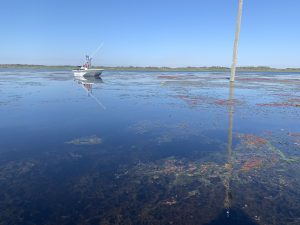
Plants are important to aquatic ecosystems. However, sometimes aquatic plant management is necessary. But if plants are important, why are aquatic plants sometimes managed? Well, the key to a healthy aquatic ecosystem is a wide diversity of native plants. Problems arise when invasive plants are introduced. These are plants that are not native to Florida and do not have natural predators that keep them in check. As a result, they can begin to over-grow and dominate aquatic systems. While many people think “green is good”, there are plants that simply are not good for aquatic ecosystems. Invasive aquatic plants can quickly overwhelm an ecosystem either floating on the water’s surface (like water hyacinth) or growing underwater (like hydrilla). Either way these plants can cause some problems.
In our last blog, we shared three ways aquatic plants serve our environment by providing habitat, oxygen, and water clarity. However, invasive plants negatively impact habitat, oxygen, and water clarity:
Habitat Loss. A healthy ecosystem requires a wide variety of plants to support a wide variety of aquatic organisms. When invasive plants dominate a lake, the diversity of plants and other critters start to decline. This loss of habitat has a large impact on what can use this water and significant changes can occur.
Low Oxygen. Floating or submersed aquatic plants can crowd or shade out the native plants that live in the water. Lack of sunlight means photosynthesis stops and so does the oxygen release. Meanwhile, floating invasive plants prevent diffusion of oxygen from the air into the water. All these factors combine to result in low oxygen conditions and fish kills can result.
Lack of Water Clarity. Invasive plants grow a lot faster than native plants, although they filter nutrients from the water, they are always releasing nutrients at a faster pace. This leads to tremendous muck accumulation on the bottom of lakes and rivers as well as dead/decaying plant matter in the water. The result is a loose and “muddy” water conditions.
Aquatic plants are essential to a healthy ecosystem, but not every plant plays nicely.
Aquatic plants are essential to a healthy ecosystem, but not every plant plays nicely. A healthy aquatic ecosystem needs a wide diversity of native plants, all growing in specific areas and providing specific functions for the environment. Invasive plants threaten these natives and must be routinely managed so they do not overgrow and overwhelm the water. Applying the proper management technique, at the proper time, can restore the balance of an aquatic ecosystem by shifting the odds back in favor of the desirable natives. While Florida’s freshwater systems seem ancient and self-sustaining, they actually need a considerable level of management so they can continue to provide drinking water, flood protection, and wonderful experiences for all of us to enjoy!
Questions or comments can be sent to the UF/IFAS CAIP communications manager at caip@ifas.ufl.edu. Follow UF/IFAS CAIP on Instagram.
Subscribe for more blogs like this one.
UF/IFAS Center for Aquatic and Invasive Plants. Turning Science Into Solutions.
Did you find this post helpful or interesting? Click the heart below!
 4
4
